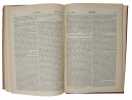"DARWIN, C. R.
Pangenesis. - [DARWIN'S FERENSE OF HIS PANGENESIS-THEORY.]
London and New York, Macmillan and Co., 1871. Royal8vo. In publisher's original red embossed cloth. In ""Nature. A Weekly Illustrated Journal of Science"", Vol. 3, November 1870 - April 1871. Stamp to title-page and ex-libris pasted on to pasted down front end-paper. Binding with considerable wear"" spine partly disintegrated and front board bended vertically, but bookblock firmly attached. Internally fine and clean. Darwin's paper: Pp. 502-503. [Entire volume: XII, 520 pp].
Reference : 60107
First appearance of Darwin’s defense of his Pangenesis-theory. The Pangenesis theory was hypothetical mechanism for heredity, in which he proposed that each part of the body continually emitted its own type of small organic particles called gemmules that aggregated in the gonads, contributing heritable information to the gametes. He presented this 'provisional hypothesis' in his 1868 work The Variation of Animals and Plants Under Domestication, intending it to fill what he perceived as a major gap in evolutionary theory at the time. Darwin's half-cousin Francis Galton spent much time conducting wide-ranging inquiries into heredity which led him to refute Charles Darwin's hypothetical theory of pangenesis. In consultation with Darwin, he set out to see if gemmules were transported in the blood. Galton was troubled because he began the work in good faith, intending to prove Darwin right, and having praised pangenesis in Hereditary Genius in 1869. Cautiously, he criticized his cousin's theory, although qualifying his remarks by saying that Darwin's gemmules, which he called ""pangenes"", might be temporary inhabitants of the blood that his experiments had failed to pick up. In the present paper Darwin challenged the validity of Galton's experiment, giving his reasons in an article published in Nature where he wrote. “Now, in the chapter on Pangenesis in my Variation of Animals and Plants under Domestication, I have not said one word about the blood, or about any fluid proper to any circulating system. It is, indeed, obvious that the presence of gemmules in the blood can form no necessary part of my hypothesis" for I refer in illustration of it to the lowest animals, such as the Protozoa, which do not possess blood or any vessels" and I refer to plants in which the fluid, when present in the vessels, cannot be considered as true blood."" He goes on to admit: ""Nevertheless, when I first heard of Mr. Galton's experiments, I did not sufficiently reflect on the subject, and saw not the difficulty of believing in the presence of gemmules in the blood.” (From the present paper) The hypothesis was finally refuted in the 1900ies after Gregor Mendel's theory of the particulate nature of inheritance was accepted. The Pangenesis-theory, however, may be considered an eclectic mix of DNA, RNA, proteins and prions, and can be regarded as being one of the earliest steps toward the modern mechanism for heredity, namely DNA and RNA. Freeman 1751
Bookseller's contact details
Herman H. J. Lynge & Son
William Schneider
Silkegade 11
1113 Copenhagen
Denmark
+45 33 155 335
Payment mode
Sale conditions
All items may be returned for a full refund for any reason within 14 days of receipt.
 Write to the booksellers
Write to the booksellers




